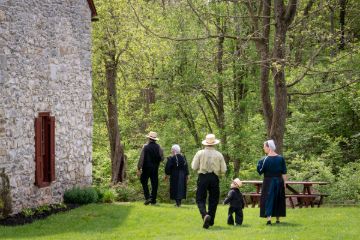Zeiten der Verfolgung - Times of Persecution
Times of Persecution - Times of Drought - Times of New Beginnings
"Heinrich Sumer and Jacob Mandel, drowned at Baden Anno 1582". (From: Martyrs' Mirror, picture credits 1).
Due to its radical criticism, Anabaptism quickly draws the ire of the powerful. Despite (or because of) the persecution, the movement soon spreads not only in Switzerland, but also across Europe to Russia, and later to North and South America.

Today Amish Anabaptists live primarily in North America. Photo: Three generations on the restored Nicholas and Anna Elizabeth Bachmann Stoltzfus homestead, Wyomissing Pennsylvania, USA. (Photo: Nicholas Stoltzfus, photo credit 2).
Prison, torture, confiscation of goods, banishment and execution drive Anabaptism more and more into isolation and into a sometimes theological narrowness. Internal conflicts lead to the emergence of the Amish in 1693.
Impulses from Pietism and revivalist movements later caused Anabaptist congregations to grow again, but also led in part to a retreat as "the silent in the state."
It was not until the Enlightenment and the French Revolution that Swiss Anabaptism gained more freedom.
Preacher's visit to an Anabaptist family in the Bernese Jura. The former prince-bishopric of Basel in the Jura was a favorite escape destination for Anabaptists from the Emmental. (Aurèle Robert, The Bernese Farm. Photo credit 3).
Revivalist movements in the 19th century lead to a renewal of faith and spirituality throughout the religious landscape, but also to new tensions and divisions. New Anabaptist churches also emerge, such as the "Neutäufer" / ETG (from 1832). And Baptists from the Anglo-Saxon region now also found congregations in Switzerland.
Until the 20th century, the principle of non-violence, which was important for "historic peace churches", gave rise to conflicts with the authorities. Their commitment ultimately contributed to the introduction of civilian service in Switzerland as well.



